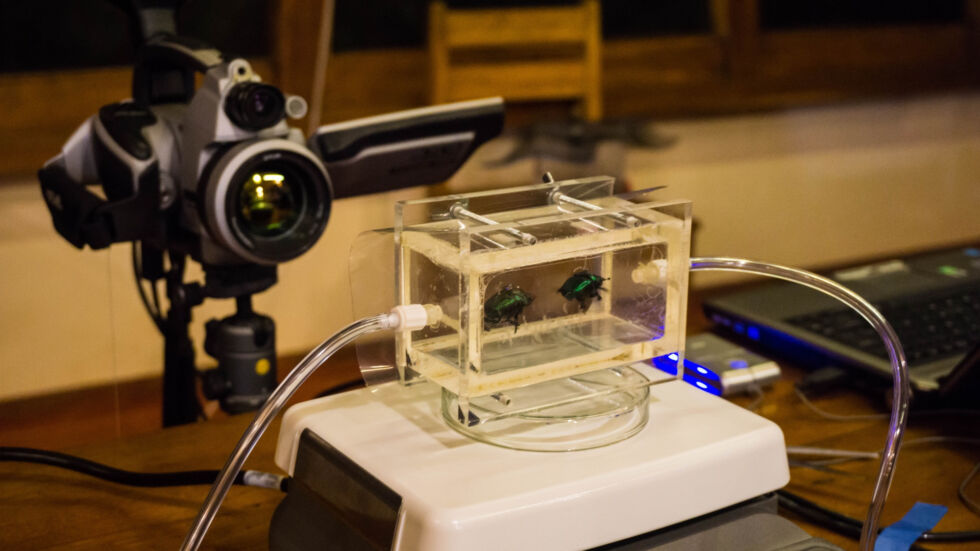
Peru’s Manu Biosphere Reserve is the largest rainforest reserve in the world and one of the most biodiverse spots on the planet. Manu is a UNESCO-protected area the size of Connecticut and Delaware combined, covering an area where the Amazon River Basin meets the Andes Mountain Range. This combination forms a series of unique ecosystems, where species unknown to science are discovered every year. The remoteness of the region has helped preserve its biodiversity but adds to the challenges faced by the scientists who are drawn to study it.
Trapping wildlife for research in the dense jungle is impractical, especially considering the great distances researchers have to travel within Manu, either through the forest or on the waterways. It’s an expensive proposition that inevitably exposes the trapped animals to some amount of risk. Trapping rare and endangered animals is even more difficult and comes with significant risks to the animal.
Trapping beetles, however, does not pose the same challenges. They’re easy to catch, easy to transport, and, most importantly, carry the DNA of many animals in and on them. Any animal a biologist could hope to study leaves tracks and droppings in the forest, and the beetles make a living by cleaning that stuff up.
Beetles as DNA collectors
Beetles are plentiful in the rainforest, and the species that Alejandro Lopera-Toro’s team studies are not endangered. The study does mean that the beetles are killed, but overall, the effect on the ecosystem is minimal.
According to Peruvian biologist and team member Patricia Reyes, “The impact depends on the abundance and reproductive cycle of each species. Reducing the beetle population could have an effect on their predators, such as birds, reptiles, and other insects. The health of the forest depends on the beetles’ function to break down organic matter and disperse seeds. Despite not having found any effect on the ecosystem so far, we still limit how many individual beetles we collect and identify sensitive areas where collecting is prohibited. We promote sustainable methods of collection to mitigate possible impacts in the future.”
Getting beetles to do the work of collecting DNA for researchers took some adjustments. The traps normally used to study beetles cause the beetles to fall into a chemical solution, which kills and preserves them until they are collected. However, those traps contaminate the beetle’s stomach contents, making the DNA unusable. Lopera-Toro’s traps keep them alive, protecting the delicate strands of DNA that the beetles have worked so hard to collect. He and his team also go out into the forest to collect live beetles by hand, carefully recording the time and place each one was collected. Starting in July 2022, the team has been collecting dung beetles across Manu’s diverse ecosystems up and down the altitude gradient, from 500 to 3,500 meters above sea level.

Elena Chaboteaux
The Manu Biological Station team is using Nanopore technology to sequence the DNA found in the beetles’ stomachs, with the goal of finding out what animals are represented there. They specifically targeted dung beetles because their feeding habits depend on the feces left by larger animals. The main advantage to the Nanopore minION device is that it can separate long lengths of DNA on-site. “Long nanopore sequencing reads provide enhanced species identification, while real-time data analysis delivers immediate access to results, whether in the field or in the lab,” according to the Nanopore website.
Biologist Juliana Morales acknowledges that Nanopore still has a high rate of error, though as this new technology is refined, that issue is continually decreasing. For the purposes of the Manu Biological Station team, the margin of error is a price they’re willing to pay to have devices they can use in the rainforest. Since they’re not studying one specific species, but rather building a database of the species present in the region, they don’t need to get every nucleotide correct to be able to identify the species. They do, however, need a strand long enough to differentiate between a common woolly monkey and a yellow-tailed woolly monkey.
Though the researchers prefer to sequence DNA on-site with Nanopore minION devices, when they have more than a dozen samples to analyze, they send them to the University of Guelph in Ontario, Canada. It’s a logistical nightmare to send samples from the Peruvian jungle to Canada, but Lopera-Toro says it’s worth it. “The University of Guelph can process hundreds of DNA samples per day. I’m lucky if we can process 10 samples a day at the [Manu] lab.”
In the most recent batch of 76 samples, they analyzed the stomach contents of 27 species from 11 genera of beetles. From those 76 samples, they identified DNA of howler monkeys, spider monkeys, red brocket deer, night monkeys, peccaries, mouse opossum, Rufous-breasted wood quail, and two species of armadillos. Oddly, the beetles had also eaten about a dozen species of fruit, and one had consumed pollen from a tropical plant called syngonium.
The implications could be vast. “The dung beetle that ate the jaguar’s excrement will tell us not only the DNA of the jaguar but also what the jaguar is eating,” said Lopera-Toro. “If the jaguar kills a peccary and eats 80 percent of the peccary, beetles will eat some of the other 20 percent. If a beetle walks over a jaguar print or saliva, there could be traces of jaguar DNA on the beetle. We analyze the stomach contents and the outside of the beetle. We have an endless number of options, opportunities, and questions we can answer from studying these small insects. We can see the bigger picture of what is happening in the jungle.”

